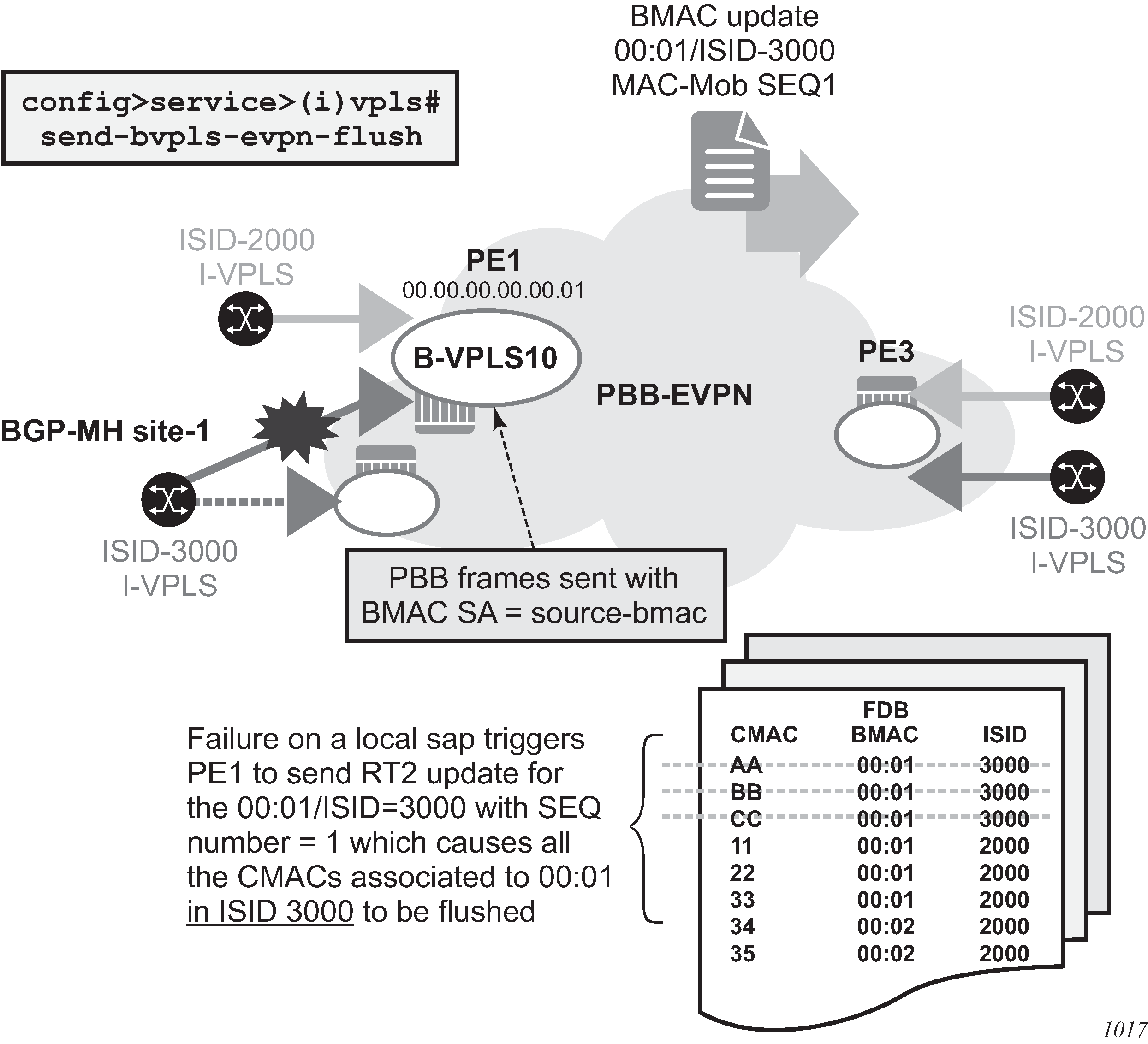SR OS supports ISID-based C-MAC flush procedures for PBB-EVPN I-VPLS services where no single-active ESs are used. SR OS also supports C-MAC flush procedure where other redundancy mechanisms, such as BGP-MH, need these procedures to avoid blackholes caused by a SAP or spoke SDP failure.
The C-MAC flush procedures are enabled on the I-VPLS service using the config>service>vpls>pbb>send-bvpls-evpn-flush CLI command. The feature can be disabled on a per-SAP or per-spoke SDP basis by using the disable-send-bvpls-evpn-flush command in the config>service>vpls>sap or config>service>vpls>spoke-sdp context.
With the feature enabled on an I-VPLS service and a SAP or spoke SDP, if there is a SAP or spoke SDP failure, the router sends a C-MAC flush notification for the corresponding B-MAC and ISID. The router receiving the notification flushes all the C-MACs associated with the indicated B-MAC and ISID when the config>service>vpls>bgp-evpn>accept-ivpls-evpn-flush command is enabled for the B-VPLS service.
The C-MAC flush notification consists of an EVPN B-MAC route that is encoded as follows: the ISID to be flushed is encoded in the Ethernet Tag field and the sequence number is incremented with respect to the previously advertised route.
If send-bvpls-evpn-flush is configured on an I-VPLS with SAPs or spoke SDPs, one of the following rules must be observed.
The disable-send-bvpls-evpn-flush option is configured on the SAPs or spoke SDPs.
The SAPs or spoke SDPs are not on an ES.
The SAPs or spoke SDPs are on an ES or vES with no src-bmac-lsb enabled.
The no use-es-bmac is enabled on the B-VPLS.
ISID-based C-MAC flush can be enabled in I-VPLS services with ES or vES. If enabled, the expected interaction between the RFC 7623-based C-MAC flush and the ISID-based C-MAC flush is as follows.
If send-bvpls-evpn-flush is enabled in an I-VPLS service, the ISID-based C-MAC flush overrides (replaces) the RFC 7623-based C-MAC flushing.
For each ES, vES, or B-VPLS, the system checks for at least one I-VPLS service that does not have send-bvpls-evpn-flush enabled.
If ISID-based C-MAC flush is enabled for all I-VPLS services, RFC 7623-based C-MAC flushing is not triggered; only ISID-based C-MAC flush notifications are generated.
If at least one I-VPLS service is found with no ISID-based C-MAC flush enabled, then RFC 7623-based C-MAC flushing notifications are triggered based on ES events.
ISID-based C-MAC flush notifications are also generated for I-VPLS services that have send-bvpls-evpn-flush enabled.
Figure 1 shows an example where the ISID-based C-MAC flush prevents blackhole situations for a CE that is using BGP-MH as the redundancy mechanism in the I-VPLS with an ISID of 3000.

When send-bvpls-evpn-flush is enabled, the I-VPLS service is ready to send per-ISID C-MAC flush messages in the form of B-MAC/ISID routes. The first B-MAC/ISID route for an I-VPLS service is sent with sequence number zero; subsequent updates for the same route increment the sequence number. A B-MAC/ISID route for the I-VPLS is advertised or withdrawn in the following cases:
during I-VPLS send-bvpls-evpn-flush configuration and deconfiguration
during I-VPLS association and disassociation from the B-VPLS service
during I-VPLS operational status change (up/down)
during B-VPLS operational status change (up/down)
during B-VPLS bgp-evpn mpls status change (no shutdown/shutdown)
during B-VPLS operational source B-MAC change
if no disable-send-bvpls-evpn-flush is configured for a SAP or spoke SDP, upon a failure on that SAP or spoke SDP, the system sends a per-ISID C-MAC flush message; that is, a B-MAC/ISID route update with an incremented sequence number
If the user explicitly configures disable-send-bvpls-evpn-flush for a SAP or spoke SDP, the system does not send per-ISID C-MAC flush messages for failures on that SAP or spoke SDP.
The B-VPLS on the receiving node must be configured with bgp-evpn>accept-ivpls-evpn-flush to accept and process C-MAC flush non-zero Ethernet-tag MAC routes. If the accept-ivpls-evpn-flush command is enabled (the command is disabled by default), the node accepts non-zero Ethernet-tag MAC routes (B-MAC/ISID routes) and processes them. When a new B-MAC/ISID update (with an incremented sequence number) for an existing route is received, the router flushes all the C-MACs associated with that B-MAC and ISID. The B-MAC/ISID route withdrawals also cause a C-MAC flush.
The following CLI example shows the commands that enable the C-MAC flush feature on PE1 and PE3.
*A:PE-1>config>service>vpls(i-vpls)# info
----------------------------------------------
pbb
backbone-vpls 10
send-bvpls-evpn-flush
exit
exit
bgp
route-distinguisher 65000:1
vsi-export ‟vsi_export”
vsi-import ‟vsi_import”
exit
site ‟CE-1” create
site-id 1
sap lag-1:1
site-activation-timer 3
no shutdown
exit
sap lag-1:1 create
no disable-send-bvpls-evpn-flush
no shutdown
exit
<snip>
*A:PE-3>config>service>vpls(b-vpls 10)# info
----------------------------------------------
<snip>
bgp-evpn
accept-ivpls-evpn-flush
In the preceding example, with send-bvpls-evpn-flush enabled on the I-VPLS service of PE1, a B-MAC/ISID route (for pbb source-bmac address B-MAC 00:..:01 and ISID 3000) is advertised. If the SAP goes operationally down, PE1 sends an update of the source B-MAC address (00:..:01) for ISID 3000 with a higher sequence number.
With accept-ivpls-evpn-flush enabled on PE3’s B-VPLS service, PE3 flushes all C-MACs associated with B-MAC 00:01 and ISID 3000. The C-MACs associated with other B-MACs or ISIDs are retained in PE3’s FDB.